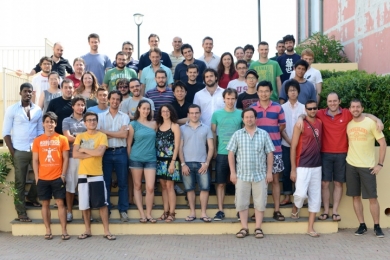Special Issue on on whole-body control of contacts and dynamics for humanoid robots
For humanoid robots to act in unstructured natural environments as humans do, contacts and physical interactions are necessary and unavoidable. In recent years, whole-body control techniques have matured to the point where various humanoid robots can robustly interact with their environment. Robots may exploit predictable contacts to aid in goal achievement, as well as learn dynamics of contact to generalize over novel tasks and domains. They may regulate their compliance to cope with unpredictable contacts and ensure safe behaviors. While these achievements are a major milestone for robotics, they still need to be applied to more challenging situations, inspired by natural settings and physical interaction scenarios. There is a strong need for advanced methods that can handle multiple contacts, unforeseen or intentional, with different rigidity properties, and guarantee the robust, autonomous execution of actions (balancing, walking, manipulation) in variable contexts.
This increased interest for whole-body control led Serena Ivaldi, Jan Babic, Michael Mistry and Robin Murphy to organize a special issue of the Autonomous Robots journal on the topic of whole-body control of contacts and dynamics.
The special issue aims at presenting the advances in whole-body control of real robots, focusing on control and learning techniques applied to estimation, control and adaptation of whole-body dynamics movement and contact forces that go beyond basic balancing abilities.
The special issue received support from CODYCO and the IEEE-RAS TC on Whole-Body Control.
***
***
The robots in this special issue:

The list of selected papers:
- Optimization-based locomotion planning, estimation and control design for the Atlas humanoid robot by Kuindersma et al.
- Balancing of humanoid robot using contact force/moment control by task-oriented whole-body control framework by Lee et al.
- Momentum control with hierarchical inverse dynamics on a torque-controlled humanoid by Herzog et al.
- Whole-body hierarchical motion and force control for humanoid robots by Liu et al.
- Whole-body impedance control of wheeled mobile manipulators: stability analysis and experiments on the humanoid robot Rollin' Justin by Dietrich et al.
- Knowledge-enabled parameterization of whole-body control strategies for compliant service robots by Leidner et al.
- Model predictive control for fast reaching in clutter by Killpack et al.
- Multi-contact vertical ladders climbing with a HRP-2 humanoid by Vaillant et al.
***
INFORMATION NOTICE ON PERSONAL DATA PROCESSING
We hereby inform users of this website, in accordance with Art. 13 of Italian Legislative Decree 196/2003 as amended and supplemented and in compliance with the Measure of the Italian Data Protection Authority no. 229 dated 8 May 2014, that browsing on this website involves the acquisition of some data, whose transmission to Fondazione Istituto Italiano di Tecnologia (hereafter, “IIT”) occurs automatically by way of Internet communication protocols. In particular, this website uses the following types of cookies: browsing/session cookies, analytics cookies, functional cookies and third parties cookies. We also note that this website does not use cookies to transmit information of a personal data; it does not use profiling cookies or systems for tracking users.
1. PURPOSES OF PROCESSING AND TYPES OF COOKIES USED
The processing purposes refer to browsing on this website, which uses the types of cookies described below.
Browsing/session cookies
The use of so-called browsing/session cookies - which are not stored persistently on the user's computer and are deleted upon closing the browser - is strictly limited to the transmission of session identifiers (constituted by random numbers generated by the server) required to allow the secure and efficient exploration of the website. In particular, the computer systems and software procedures used to operate this website acquire, during their normal operation, some data whose transmission is implicit in the use of Internet communication protocols. This information is not collected to be associated with identified interested parties but, by its very nature, it may, via processing and association with data held by third parties, allow for users to be identified.
Analytics cookies
The use of so-called analytics cookies occurs for the sole purpose of obtaining anonymous statistical information on use of the website (e.g. the number of visitors to the website, the origin of visitors to the website or the operating system used) and to check its correct operation. This category of data includes IP addresses or domain names of the computers used by users who connect to the website, the addresses in URI (Uniform Resource Identifier) notation of the requested resources, the time of the request, the method used in submitting the request to the server, the size of the file obtained in response, the numerical code indicating the status of the response given by the server (successful, error, etc.) and other parameters relating to the user's operating system and computer environment.
Functional cookies
The use of so-called functional cookies on this website occurs exclusively to allow the user to browse based upon selected criteria.
Third party cookies
This website uses cookies originating from the following third parties:
- Twitter.com
- Google.com
In particular:
- cookies originating from google.com are used for browsing statistics (Google Analytics);
- cookies originating from twitter.com are used to identify users to Twitter: if the user does not have a Twitter account or has never accessed Twitter.com website directly, then Twitter will assign the user a unique code to track the user’s visit to the twitter feed (this cookie will expire in two years after creation).
2. PROCESSING METHODS
The data may be processed both by way of computer media and on paper, in compliance with the rules in relation to personal data protection, therein including those relating to data security.
3. MANDATORY OR OPTIONAL NATURE OF DATA PROVISION
The provision of the data via this website is optional. In particular, users can express their options concerning the use of cookies by this website also via the browser settings. Below are the links that illustrate the procedures to be followed to configure the settings of the most popular browsers:
- Mozilla Firefox: https://support.mozilla.org/en-US/kb/enable-and-disable-cookies-website-preferences
- Internet Explorer: http://windows.microsoft.com/it-it/windows-vista/block-or-allow-cookies
- Chrome : https://support.google.com/accounts/answer/61416?hl=en
- Opera : http://www.opera.com/help/tutorials/security/privacy/
- Safari : https://support.apple.com/kb/PH17191?locale=en_US
Users are in any case free to provide their personal data voluntarily by sending requests to the e-mail addresses found on the website; in this case, any failure to provide the same may involve the impossibility by IIT to reply to the request received.
4. CATEGORIES OF ENTITIES TO WHICH THE DATA MAY BE COMMUNICATED
Any data provided by users will not be communicated to entities external to IIT. This is without prejudice to IIT's obligation to communicate the data to the Judicial Authority at any time a specific request is sent in that regard.
5. PROCESSING CONTROLLER
The Processing Controller of data provided by users is Fondazione Istituto Italiano di Tecnologia, based in Genoa, Via Morego no. 30.
6. RIGHTS OF THE INTERESTED PARTY
The persons to whom the personal data refers have the right at any time to obtain confirmation of the existence or otherwise of that data and to know of its content and origin, to verify its accuracy or to request its supplementation, update or rectification (Art. 7 of Italian Legislative Decree no. 196/2003). In particular, the interested party has the right to obtain an indication:
- of the origin of the personal data;
- of the purposes and methods of processing;
- of the logic applied in the case of processing performed using electronic tools;
- of the identification details of the controller, managers and appointed representative in accordance with Article 5, Paragraph 2;
- of the entities or categories of entities to which the personal data may be communicated or which may come to know of it in the capacity of appointed representative in the State territory, managers or officers.
The interested party has the right to obtain:
- the update, rectification or, where appropriate, supplementation of the data;
- the deletion, transformation into anonymous form or block of data processed in breach of the law, including that whose storage is not necessary in relation to the purposes for which the data was collected or subsequently processed;
- certification that the operations referred to in letters a) and b) have been brought to the attention, also as regards their content, of those to whom the data has been communicated or disseminated, except where that fulfillment is found to be impossible or involves the use of means manifestly disproportionate to the protected right.
The interested party has the right to object, in whole or in part:
- for legitimate reasons, to the processing of personal data relating to him/her, even if pertinent to the purpose of its collection;
- to the processing of personal data relating to him/her for the purposes of sending advertising material or direct sales or for the completion of market research or commercial communication.
Survey on Dynamics Simulation
On September 2013, we created a survey about the use of dynamic simulation tools in robotics. The survey was motivated by the growing number of tools for dynamics simulation, and our need to figure out which is the best tool for our researches:
which is the best tool for simulating dynamics and contacts?
The survey was advertised on the main robotics mailing lists (robotics-worldwide, euron-dist, ..). We collected 119 answers in one month.
You can see here the online survey about dynamics simulation tools (link)
You can read the results of the survey together with a review of the main simulators for robot dynamics in this paper:
Ivaldi, S.; Peters, J.; Padois, V.; Nori, F. (2014). Tools for simulating humanoid robot dynamics: a survey based on user feedback, Proceedings of the International Conference on Humanoid Robots (HUMANOIDS). (pdf)
Serena Ivaldi, Vincent Padois, Francesco Nori. Tools for dynamics simulation of robots: a survey based on user feedback. arXiv:1402.7050 [cs.RO]








